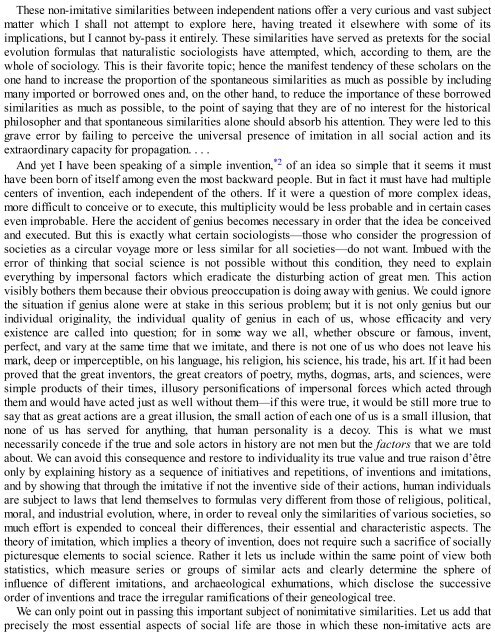3658925934
You also want an ePaper? Increase the reach of your titles
YUMPU automatically turns print PDFs into web optimized ePapers that Google loves.
These non-imitative similarities between independent nations offer a very curious and vast subject<br />
matter which I shall not attempt to explore here, having treated it elsewhere with some of its<br />
implications, but I cannot by-pass it entirely. These similarities have served as pretexts for the social<br />
evolution formulas that naturalistic sociologists have attempted, which, according to them, are the<br />
whole of sociology. This is their favorite topic; hence the manifest tendency of these scholars on the<br />
one hand to increase the proportion of the spontaneous similarities as much as possible by including<br />
many imported or borrowed ones and, on the other hand, to reduce the importance of these borrowed<br />
similarities as much as possible, to the point of saying that they are of no interest for the historical<br />
philosopher and that spontaneous similarities alone should absorb his attention. They were led to this<br />
grave error by failing to perceive the universal presence of imitation in all social action and its<br />
extraordinary capacity for propagation. . . .<br />
And yet I have been speaking of a simple invention, *2 of an idea so simple that it seems it must<br />
have been born of itself among even the most backward people. But in fact it must have had multiple<br />
centers of invention, each independent of the others. If it were a question of more complex ideas,<br />
more difficult to conceive or to execute, this multiplicity would be less probable and in certain cases<br />
even improbable. Here the accident of genius becomes necessary in order that the idea be conceived<br />
and executed. But this is exactly what certain sociologists—those who consider the progression of<br />
societies as a circular voyage more or less similar for all societies—do not want. Imbued with the<br />
error of thinking that social science is not possible without this condition, they need to explain<br />
everything by impersonal factors which eradicate the disturbing action of great men. This action<br />
visibly bothers them because their obvious preoccupation is doing away with genius. We could ignore<br />
the situation if genius alone were at stake in this serious problem; but it is not only genius but our<br />
individual originality, the individual quality of genius in each of us, whose efficacity and very<br />
existence are called into question; for in some way we all, whether obscure or famous, invent,<br />
perfect, and vary at the same time that we imitate, and there is not one of us who does not leave his<br />
mark, deep or imperceptible, on his language, his religion, his science, his trade, his art. If it had been<br />
proved that the great inventors, the great creators of poetry, myths, dogmas, arts, and sciences, were<br />
simple products of their times, illusory personifications of impersonal forces which acted through<br />
them and would have acted just as well without them—if this were true, it would be still more true to<br />
say that as great actions are a great illusion, the small action of each one of us is a small illusion, that<br />
none of us has served for anything, that human personality is a decoy. This is what we must<br />
necessarily concede if the true and sole actors in history are not men but the factors that we are told<br />
about. We can avoid this consequence and restore to individuality its true value and true raison d’être<br />
only by explaining history as a sequence of initiatives and repetitions, of inventions and imitations,<br />
and by showing that through the imitative if not the inventive side of their actions, human individuals<br />
are subject to laws that lend themselves to formulas very different from those of religious, political,<br />
moral, and industrial evolution, where, in order to reveal only the similarities of various societies, so<br />
much effort is expended to conceal their differences, their essential and characteristic aspects. The<br />
theory of imitation, which implies a theory of invention, does not require such a sacrifice of socially<br />
picturesque elements to social science. Rather it lets us include within the same point of view both<br />
statistics, which measure series or groups of similar acts and clearly determine the sphere of<br />
influence of different imitations, and archaeological exhumations, which disclose the successive<br />
order of inventions and trace the irregular ramifications of their geneological tree.<br />
We can only point out in passing this important subject of nonimitative similarities. Let us add that<br />
precisely the most essential aspects of social life are those in which these non-imitative acts are









![Genki - An Integrated Course in Elementary Japanese II [Second Edition] (2011), WITH PDF BOOKMARKS!](https://img.yumpu.com/58322134/1/180x260/genki-an-integrated-course-in-elementary-japanese-ii-second-edition-2011-with-pdf-bookmarks.jpg?quality=85)
![Genki - An Integrated Course in Elementary Japanese I [Second Edition] (2011), WITH PDF BOOKMARKS!](https://img.yumpu.com/58322120/1/182x260/genki-an-integrated-course-in-elementary-japanese-i-second-edition-2011-with-pdf-bookmarks.jpg?quality=85)





